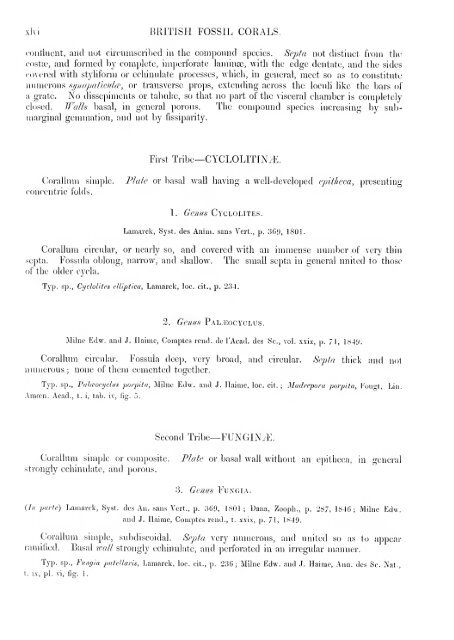A monograph of the British fossil corals - kreidefossilien.de
A monograph of the British fossil corals - kreidefossilien.de
A monograph of the British fossil corals - kreidefossilien.de
You also want an ePaper? Increase the reach of your titles
YUMPU automatically turns print PDFs into web optimized ePapers that Google loves.
.<br />
xlvi<br />
BRITISH FOSSIL CORALS.<br />
coiiHuent, and not circumscribed in <strong>the</strong> compound species. Septa not distinct from <strong>the</strong><br />
costae, and formed by complete, imperforate laminae, with <strong>the</strong> edge <strong>de</strong>ntate, and <strong>the</strong> si<strong>de</strong>s<br />
covered with styliform or echinidate processes, which, in general, meet so as to constitute<br />
numerous synapaticula , or transverse props, extending across <strong>the</strong> loculi like <strong>the</strong> bars <strong>of</strong><br />
a grate. No dissepiments or tabulae, so that no part <strong>of</strong> <strong>the</strong> visceral chamber is completely<br />
closed. Walls basal, in general porous. The compound species increasing by submarginal<br />
gemmation, and not by fissiparity.<br />
Fii-st Tribe—CYCLOLITIN^.<br />
Corallum simple. Plate or basal wall having a well-<strong>de</strong>veloped epiiheca, presenting<br />
concentric folds.<br />
1. Genns Cyclolites.<br />
Lamarck, Syst. <strong>de</strong>s Anim. sans Vert., p. 369, 1801.<br />
Corallum circular, or nearly so, and covered with an immense number <strong>of</strong> very thin<br />
septa. Fossula oblong, narrow, and shallow. The small septa in general united to those<br />
<strong>of</strong> <strong>the</strong> ol<strong>de</strong>r cycla.<br />
Typ. sp., Cyclolites ellipiica, Lamarck, loc. cit., p. 234.<br />
2. Genus Pal^ocyclus.<br />
Milne Edw. and J. Haime, Comptes rend, <strong>de</strong> I'Acad. <strong>de</strong>s Sc, vol. xxi.x, p. 71, 1849.<br />
Corallum circular. Fossula <strong>de</strong>ep, very Inroad, and circular. Septa thick and not<br />
numerous ; none <strong>of</strong> <strong>the</strong>m cemented toge<strong>the</strong>r.<br />
Typ. sp., PalcBocyclus porpita, Milne Edw. and J. Haime, loc. cit. ; Madrepora porpita, Fougt, Lin.<br />
Amoen. Acad., t. i, tab. iv, fig. 5.<br />
Second Tribe—FUNGIN^.<br />
Corallum simple or composite. Plate or basal wall without an epi<strong>the</strong>ca, in general<br />
strongly echinulate, and porous.<br />
3. Genus Fungia.<br />
{In parte) Lamarck, Syst. <strong>de</strong>s An. sans Vert., p. 369, 1801; Dana, Zooph., p. 287, 1846; Milne Edw.<br />
and J. Haime, Comptes rend., t. xxi.x, p. 71, 1849.<br />
Corallum simple, subdiscoidal. Septa very numerous, and united so as to appear<br />
ramified. Basal wall strongly echinulate, and perforated in an irregidar manner.<br />
Typ. sp., Fungia patellaris, Lamarck, loc. cit., p. 236 ; Milne Edw. and J. Haime, Ann. <strong>de</strong>s Sc. Nat.,<br />
t. ix, pi. vi, fig. 1
















